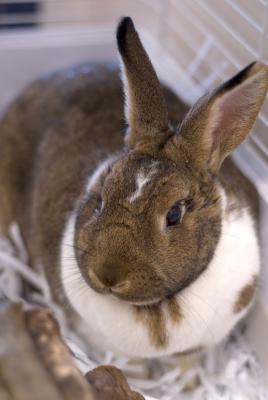May 2011 is National Vaccination Month, the ideal time to restore your rabbit's protection against the most Myxomatosis. Myxomatosis is the most important infectious disease of the rabbit. During National Vaccination Month, participating vets will give your rabbit a free second dose of the vaccine, six months after the first injection.
The threat of disease. If your rabbit hasn't been vaccinated in the last 9 months, its immunity to myxomatosis may have lapsed. Myxomatosis is almost always fatal and causes much suffering. Common throughout the UK, it spreads from the wild rabbit population, usually via blood-sucking insects such as the common rabbit flea. The disease is widespread and is seen year round, although the biggest risk period is late summer and autumn.
Myxomatosis is caused by the myxoma virus, a type of pox virus that only affects rabbits. It was first discovered in 1896 in Uruguay and was imported to Australia in 1951 to control its large rabbit populations - initially having the desired devastating effect. The disease was illegally introduced to France in 1952 and it appeared in Britain the following year. It quickly spread to both wild and domestic rabbit populations and within a few years had spread throughout Europe. Myxomatosis has been a threat to wild and domestic rabbits ever since. Myxomatosis is typically spread by blood sucking insects and in particular the rabbit flea, Spilopsyllus cuniculi.
This flea is frequently found on wild rabbits and transmission in the absence of bites is unusual. All breeds of domestic rabbit can be affected, with little to suggest that one breed is more susceptible than another, and whatever the lifestyle of your rabbit there is a potential risk of this disease. The incubation period varies depending on the strain and its virulence and is typically at least five days. Accompanying the classic bulging eyes that most of us associate with myxomatosis, are localised swellings around the head, face, ears, lips, anus and genitalia. Severe swellings can lead to blindness and distortion around the face within a day or so of the onset of symptoms, leading to difficulty with feeding and drinking. Bacterial respiratory infection often complicates the disease resulting in a fatal pneumonia.
Progress of the disease may be slower in well cared for pet rabbits and recovery is sometimes possible with intensive care. However, myxomatosis can be a very protracted and profoundly unpleasant disease and euthanasia is generally recommended. Recovery in the wild occasionally occurs but for animals with severe signs death usually occurs about 12 days after initial infection.
There is no specific treatment for the virus and any treatment offered is merely supportive. Treatment is occasionally contemplated but would not usually be recommended for rabbits with the full-blown disease since affected individuals suffer dreadfully, have a low chance of survival and they remain a source of infection for other rabbits. The occasional individuals with milder disease may, however, recover with appropriate care.
Control of myxomatosis, to help prevent your rabbit from contracting myxomatosis, it is important to put various controls in place, for which there are two main methods: control of parasites and vaccination. Don't delay, vaccinate your rabbit in May.

 How to Make a Rabbit Litter Pan
How to Make a Rabbit Litter Pan
How to
How to Make a Rabbit Litter Pan
How to Make a Rabbit Litter Pan
How to
 Rabbit Ear Infection Symptoms and Treatment
Rabbit
Rabbit Ear Infection Symptoms and Treatment
Rabbit
 How to Wash Rabbit Fur
How to Wash Rabbit Fur
How to Wash Rab
How to Wash Rabbit Fur
How to Wash Rabbit Fur
How to Wash Rab
 Directions on How to Build a Cage for an Outside Rabbit
Directions on How to Build a Cage for an Outsi
Directions on How to Build a Cage for an Outside Rabbit
Directions on How to Build a Cage for an Outsi
 What to Put in a Rabbit Cage
What to Put in a Rabbit Cage
What to P
What to Put in a Rabbit Cage
What to Put in a Rabbit Cage
What to P